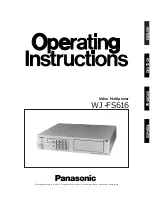
DVM68
25.02.2011
10
7.6 Transistor Test
Do not perform transistor measurements on live circuits.
•
Set the function switch at hFE position.
•
Identify whether the transistor is NPN or PNP type and locate emitter, base and collector lead.
•
Insert leads of the transistor to be tested into proper holes of the testing socket on the front
panel.
•
LCD display will show the approximate hFE value at the test condition of base current 10 µA
and Vce 3.2V.
8.
Cleaning and maintenance
Do not
replace internal parts yourself. Replace damaged or lost accessories by identical
ones with the same specifications. Order spare accessories e.g. test probes at your deale
Switch off the meter and remove test leads prior to replacing the battery or fuses.
WARNING:
To avoid electrical shock
always
disconnect the test leads prior to opening
the housing.
Remark:
refer to the warning on the back of the meter
a. General mainenance:
•
Wipe the device regularly with a moist, lint-free cloth. Do not use alcohol or solvents.
b.
Fuse Replacement
•
Remove test probes from the circuit under test. Remove the test probes from the input jacks.
•
Switch off the multi-meter.
•
Remove the 3 screws at the back and gently open the meter.
•
Remove the fuse from the fuse holder and replace it with a new fuse of the same type and
with the same specifications (F300mA/250V, Ø5x20mm – F10A/250V, Ø6
•
Close the meter carefully.
c. Battery Replacement
•
Remove the battery as soon as the “
” indication appears on the display.
•
Remove test probes from the circuit under test. Remove all test leads from the input jacks.
•
Switch off the multi-meter.
•
Remove the 3 screws at the back and gently open the meter.
•
Replace the battery by a new battery of the same type and with the same specifications
(6LR61/6F22 9V alkaline, do not use rechargeable batteries)
•
Close the meter carefully
Notes:
o
Never open the housing when test leads are connected to the input jacks
o
Do not try to repair or calibrate the meter yourself; contact your dealer.
o
Replace damaged accessories immediately; order them at your local dealer.
o
Do not use the meter when it is damaged.
9.
Technical specifications
This device is not calibrated when purchased!
Regulations concerning environment of use:
•
Use this meter only for measurements in CAT I, CAT II and CAT III environments (see §4)
•
Use this meter only in a pollution degree 2 environment (see §5)
Max. voltage between terminal and earth 1000V DC or 750V AC rms (sinus)
Display
3 ¾ digit LCD, 3260 counts max,
2-3 readings / sec
Fuse protection
µA & mA range : F 300mA/250V
A range : F 10A/250V
Power Supply
9V battery
Ranging method
Auto / Manual
Polarity indication
" - " displayed
Rev. 01
©Velleman nv
Identify whether the transistor is NPN or PNP type and locate emitter, base and collector lead.
Insert leads of the transistor to be tested into proper holes of the testing socket on the front
test condition of base current 10 µA
replace internal parts yourself. Replace damaged or lost accessories by identical
ones with the same specifications. Order spare accessories e.g. test probes at your dealer.
prior to replacing the battery or fuses.
disconnect the test leads prior to opening
free cloth. Do not use alcohol or solvents.
Remove test probes from the circuit under test. Remove the test probes from the input jacks.
Remove the fuse from the fuse holder and replace it with a new fuse of the same type and
0V, Ø6.3x30mm).
” indication appears on the display.
from the input jacks.
Replace the battery by a new battery of the same type and with the same specifications
input jacks.
Do not try to repair or calibrate the meter yourself; contact your dealer.
Replace damaged accessories immediately; order them at your local dealer.
environments (see §4)
1000V DC or 750V AC rms (sinus)
3 ¾ digit LCD, 3260 counts max,
µA & mA range : F 300mA/250V
A range : F 10A/250V











































